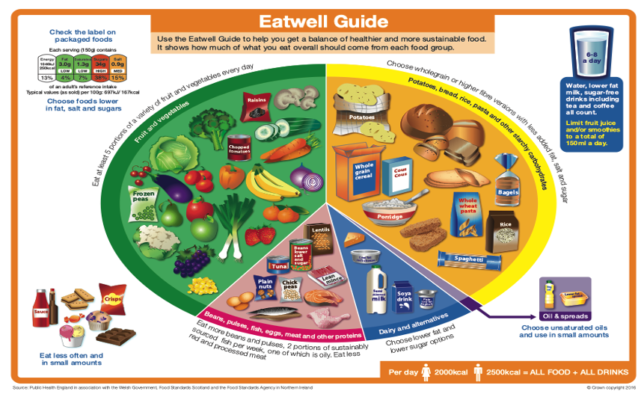
(The Eatwell Guide (Source: Public Health England, 2016).
Public Health England (PHE) regularly reviews dietary recommendations as part of its role in promoting public health. In light of evidence about our diet and health, particularly revised recommendations on sugars and fibre, the Eatwell Guide was developed in 2016 as a new healthy eating guide for the UK.
The Key messages of the Eat Well Guide
- The Eatwell Guide shows the proportions in which different groups of foods are needed in order to have a well-balanced and healthy diet.
- The proportions shown are representative of food eaten over a day or more, not necessarily at each meal time.
- Choose a variety of different foods from each food group to help get the wide range of nutrients the body needs to stay healthy .
In summary the Eat Well guide recommends the following:
- Eat at least 5 portions of a variety of fruit and vegetables every day.
- Base meals on potatoes, bread, rice, pasta or other starchy carbohydrates; choosing wholegrain versions where possible.
- Have some dairy or dairy alternatives (such as soya drinks); choosing lower fat and lower sugar options.
- Eat some beans, pulses, fish, eggs, meat and other proteins (including 2 portions of fish every week, one of which should be oily).
- Choose unsaturated oils and spreads and eat in small
- Drink 6-8 cups/glasses of fluid a day.
- If consuming foods and drinks high in fat, salt or sugar have these less often and in small amounts.
Important things to remember:
- The one size fits all approach may not be suitable for all people. Anyone with special dietary requirements or medical needs might want to check with a registered nutritionist or dietitian on how to adapt the Eatwell Guide to meet their individual needs.
- People with wheat or gluten allergies or diary intolerance may have to cut out a whole food group, so alternative nutrients need to be considered. Likewise vegetarians and vegans need to follow a specially designed Eatwell guide as they may remove sections such as the meat, fish and alternatives and diary groups.
- It is important to not forget about food poverty. Not everyone can afford to eat meat, fish or five portions of fruit and vegetables a day, and actually research shows the statistics of this are higher than you might think.
In summary the Eatwell Guide is a visual representation of how different foods and drinks can contribute towards a healthy balanced diet. The guide applies to most people regardless of weight, dietary restrictions/preferences or ethnic origin. However seek further guidance if you have an intolerance or you follow a vegetarian or vegan dietary pattern.
CHRISTCHURCH FOOD FESTIVAL EDUCATION TRUST: CHARITY NUMBER 1127292
BOURNEMOUTH UNIVERSITY: MSc NUTRITION AND BEHAVIOUR: DANI
